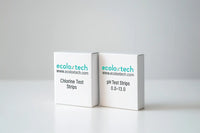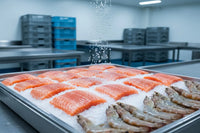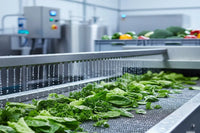Hypochlorous acid, also known as HOCl, is a powerful and versatile disinfectant that has gained significant attention in recent years. With its ability to effectively kill bacteria, viruses, and fungi while being safe for humans and the environment, hypochlorous acid is becoming increasingly popular in various industries. In this introduction, we will explore the properties, uses, and benefits of hypochlorous acid.
The Chemical Composition of Hypochlorous Acid
Hypochlorous acid (HOCl) is a weak acid that forms when chlorine gas dissolves in water. It is composed of one chlorine atom, one oxygen atom, and one hydrogen atom. The chemical formula for hypochlorous acid is HOCl. It exists as a colorless liquid with a distinct chlorine-like odor. - Hypochlorous acid is formed through the following reaction: Cl2 + H2O → HOCl + HCl. - It is important to note that hypochlorous acid exists in equilibrium with its conjugate base, hypochlorite ion (OCl-), depending on the pH of the solution. - In acidic conditions (pH below 7), hypochlorous acid predominates, while in basic conditions (pH above 7), hypochlorite ion becomes more prevalent.
Key Points:
- Chemical formula: HOCl - Composed of one chlorine atom, one oxygen atom, and one hydrogen atom - Forms when chlorine gas dissolves in water - Exists in equilibrium with hypochlorite ion (OCl-) depending on pH
Properties:
- Molecular weight: 52.46 g/mol - Melting point: -59 °C (-74 °F) - Boiling point: 52 °C (126 °F) - Density: 1.11 g/cm³
Uses:
- Disinfection and sanitization purposes - Water treatment - Wound healing and skincare products

Formation of Hypochlorous Acid in Nature
Hypochlorous acid is naturally formed in various environments and plays a crucial role in disinfection and protection against pathogens. Formation in the human body: Hypochlorous acid is produced by white blood cells, specifically neutrophils and macrophages, as part of the immune response to combat invading microorganisms. This natural production of hypochlorous acid contributes to the body's defense against infections. Formation in water bodies: Hypochlorous acid can be formed in natural water bodies through various processes. When sunlight reacts with chlorine-containing compounds, such as chloramines or organic matter, hypochlorous acid can be generated. Additionally, the addition of chlorine-based disinfectants to water sources can also result in the formation of hypochlorous acid. Formation during chlorine disinfection: In water treatment facilities and swimming pools, hypochlorous acid is formed when chlorine gas or sodium hypochlorite (bleach) is added to water for disinfection purposes. The presence of organic matter and ammonia compounds in the water can further enhance the formation of hypochlorous acid.
Key Points:
- Hypochlorous acid is naturally formed in various environments. - Produced by white blood cells in the human body as part of the immune response. - Formed in natural water bodies through reactions with sunlight and chlorine-containing compounds. - Generated during chlorine disinfection processes in water treatment facilities and swimming pools.
Importance:
The formation of hypochlorous acid in nature is crucial for maintaining a healthy environment by effectively eliminating harmful microorganisms. It serves as a natural defense mechanism within our bodies and plays a vital role in ensuring safe drinking water supplies and recreational waters free from pathogens. Understanding its formation and properties helps us harness its potential for various applications, including disinfection, wound healing, and water treatment.
Chemical Formula
Hypochlorous acid is a weak acid with the chemical formula HOCl. It consists of one hydrogen atom (H), one oxygen atom (O), and one chlorine atom (Cl). The molecular formula of hypochlorous acid indicates that it contains one hydrogen ion (H+), one hypochlorite ion (OCl-), and one water molecule (H2O). This chemical composition gives hypochlorous acid its unique properties and reactivity.
Physical Properties
Hypochlorous acid is a pale yellow liquid at room temperature, but it is commonly used in its dissolved form as a solution known as electrolyzed water or EOW. It has a characteristic pungent odor similar to bleach due to its chlorine content. Hypochlorous acid has a relatively low boiling point of around 52 degrees Celsius, which allows it to evaporate easily. It is also highly soluble in water, making it easy to dilute for various applications.
pH Level
The pH level of hypochlorous acid determines its effectiveness as a disinfectant or sanitizer. Hypochlorous acid solutions typically have a pH between 5 and 6, which falls within the mildly acidic range. This slightly acidic nature allows for better antimicrobial activity compared to other chlorine-based disinfectants like sodium hypochlorite (bleach). The pH level can be adjusted by altering the concentration of hypochlorous acid or adding other chemicals.
Oxidizing Properties
One of the key properties of hypochlorous acid is its strong oxidizing power. It readily donates oxygen atoms during chemical reactions, leading to the destruction of microorganisms and organic compounds. Hypochlorous acid achieves this through oxidation-reduction reactions where it accepts electrons from other molecules, causing them to break down. This oxidizing property makes hypochlorous acid an effective disinfectant against bacteria, viruses, and fungi.
Stability
Hypochlorous acid is relatively unstable and tends to decompose over time. It can degrade when exposed to light, heat, or certain metals. To maintain its stability and effectiveness, hypochlorous acid solutions are often produced on-site using specialized generators that control the concentration and pH level. These generators use a process called electrolysis to produce hypochlorous acid from water, salt, and electricity. By generating it as needed, the stability of the solution can be ensured. Overall, hypochlorous acid exhibits unique properties that make it a versatile disinfectant and sanitizer in various industries such as healthcare, food processing, and water treatment. Its chemical formula, physical properties like pH level and oxidizing power, as well as its stability characteristics all contribute to its efficacy in killing pathogens while being safe for use in different applications.
Mechanism of Action
Hypochlorous acid (HOCl) acts as a potent disinfectant due to its ability to disrupt essential cellular components in microorganisms. When HOCl comes into contact with bacteria, viruses, or fungi, it penetrates their cell walls and membranes. Once inside the microbial cell, HOCl oxidizes and damages crucial biomolecules such as proteins, lipids, and nucleic acids. This oxidative damage disrupts the integrity of these vital components, leading to the destruction of microorganisms.
Protein Denaturation
One of the primary mechanisms by which HOCl functions as a disinfectant is through protein denaturation. HOCl reacts with amino acids present in proteins, causing structural alterations that result in protein unfolding and loss of function. This disruption in protein structure interferes with essential cellular processes necessary for microbial survival.
Lipid Peroxidation
Another important mechanism utilized by HOCl is lipid peroxidation. HOCl reacts with unsaturated fatty acids present in microbial cell membranes, leading to the formation of lipid peroxides. These peroxides cause damage to the lipid bilayer structure and compromise the integrity of the cell membrane. As a result, essential cellular functions are disrupted, ultimately leading to microbial death.
Efficacy Against Different Pathogens
Hypochlorous acid demonstrates broad-spectrum efficacy against various pathogens including bacteria, viruses, and fungi. It effectively targets both gram-positive and gram-negative bacteria by disrupting their cellular components mentioned above. - Bacteria: HOCl has shown efficacy against common bacterial pathogens such as Staphylococcus aureus (including MRSA), Escherichia coli (E.coli), Salmonella spp., Pseudomonas aeruginosa, and many others. - Viruses: HOCl has been proven effective against enveloped viruses like influenza virus, herpes simplex virus, human immunodeficiency virus (HIV), and coronaviruses including SARS-CoV-2 (the virus responsible for COVID-19). - Fungi: HOCl demonstrates antifungal properties against various fungal species, including Candida albicans and Aspergillus spp. The broad-spectrum efficacy of HOCl makes it a valuable disinfectant in healthcare settings, food processing industries, water treatment facilities, and household applications.

Environmental Impact
Apart from the health risks associated with human exposure, hypochlorous acid can also have negative effects on the environment. When released into water bodies or soil, HOCl can react with organic matter and form harmful byproducts such as chlorinated compounds. These byproducts can disrupt ecosystems and pose risks to aquatic life.
Benefits of Using Hypochlorous Acid for Water Treatment
Hypochlorous acid (HOCl) is a powerful disinfectant and sanitizer that has gained popularity in water treatment applications due to its numerous benefits. Firstly, HOCl is highly effective in killing bacteria, viruses, and other harmful microorganisms present in water. Its broad-spectrum antimicrobial properties make it an ideal choice for ensuring safe drinking water.
Furthermore, HOCl is a non-toxic and environmentally friendly alternative to traditional chlorine-based disinfectants. Unlike chlorine, which can produce harmful byproducts such as chloramines and trihalomethanes, HOCl decomposes into harmless components after disinfection. This makes it a safer option for both human consumption and aquatic life.
Application of Hypochlorous Acid in Water Treatment
The use of hypochlorous acid in water treatment involves several key steps. Firstly, the water to be treated is tested for its microbial load and quality parameters. This helps determine the appropriate dosage of HOCl required for effective disinfection.
Once the dosage is determined, HOCl can be added to the water through various methods such as direct injection or using on-site generators that produce HOCl from salt and water. The treated water is then allowed sufficient contact time with HOCl to ensure complete disinfection before it is distributed or consumed.
Advantages of Using On-Site Hypochlorous Acid Generators
- Cost-effective: On-site generators eliminate the need for purchasing and storing large quantities of pre-made hypochlorous acid solutions, resulting in cost savings over time.
- Continuous supply: These generators provide a continuous supply of HOCl as needed, ensuring a consistent and reliable disinfection process.
- Safe and easy operation: On-site generators are designed to be user-friendly, with automated controls and safety features that minimize the risk of accidents or mishandling.
- Reduced environmental impact: By producing HOCl on-site, there is a reduced need for transportation and packaging of chemical disinfectants, leading to a smaller carbon footprint.

Overall, the use of hypochlorous acid in water treatment offers significant advantages in terms of its effectiveness, safety, and environmental impact. Whether through direct application or on-site generation, HOCl provides a reliable solution for ensuring clean and safe water for various purposes.
Food and Beverage Industry
In the food and beverage industry, hypochlorous acid is commonly used as a disinfectant and sanitizer. It is highly effective in killing bacteria, viruses, and other pathogens that can contaminate food products. Hypochlorous acid can be used to sanitize food processing equipment, surfaces, and utensils to ensure the safety and quality of the final products. Its non-toxic nature makes it an ideal choice for use in food preparation areas.
Benefits:
- Hypochlorous acid has a broad spectrum of antimicrobial activity, making it effective against a wide range of pathogens. - It does not leave any harmful residues or odors on food surfaces. - It is safe to use on various types of materials commonly found in the food industry, such as stainless steel, plastic, and glass.

Water Treatment
The water treatment industry utilizes hypochlorous acid for disinfection purposes. It is commonly used in municipal water treatment plants to kill harmful bacteria, viruses, and parasites present in the water supply. Hypochlorous acid effectively destroys pathogens and helps maintain safe drinking water for communities.
Benefits:
- Hypochlorous acid has a strong oxidizing effect that quickly neutralizes pathogens in water. - It provides residual disinfection, ensuring that the treated water remains free from microorganisms during distribution. - Compared to chlorine gas or other chemical disinfectants, hypochlorous acid is easier to handle and transport safely.
Effectiveness of Hypochlorous Acid as a Disinfectant
Hypochlorous acid (HOCl) has gained significant attention as a highly effective disinfectant. Its ability to kill bacteria, viruses, and other pathogens makes it an ideal choice for various applications. HOCl is particularly effective against a wide range of microorganisms, including drug-resistant strains that are resistant to other disinfectants.
One key advantage of HOCl is its broad-spectrum antimicrobial activity. It can effectively eliminate both gram-positive and gram-negative bacteria, fungi, and enveloped viruses. This makes it suitable for use in healthcare settings where the risk of infection transmission is high.
Mechanism of Action
The effectiveness of hypochlorous acid lies in its unique mechanism of action. When HOCl comes into contact with microorganisms, it disrupts their cellular structures by penetrating the cell walls and membranes. This leads to the destruction of essential proteins and enzymes within the cells, ultimately causing their death.
Furthermore, HOCl's oxidative properties contribute to its efficacy as a disinfectant. It reacts with various components within microbial cells, such as DNA and lipids, leading to irreversible damage and loss of function.
Comparison with Other Disinfectants
When compared to other disinfectants commonly used in healthcare settings, hypochlorous acid offers several advantages. Firstly, it has a rapid kill time against a wide range of pathogens. This means that surfaces treated with HOCl can be quickly disinfected without requiring lengthy contact times.
In addition, HOCl is safe for use on most surfaces and materials due to its low toxicity profile. Unlike many chemical disinfectants that may cause harm or damage delicate equipment or materials, hypochlorous acid is generally compatible with a variety of surfaces, including metals, plastics, and fabrics.
Furthermore, HOCl has been shown to have a residual effect, meaning it continues to provide antimicrobial protection even after the initial application. This can be particularly beneficial in high-risk areas where continuous disinfection is crucial.
List of Advantages of Hypochlorous Acid:
- Broad-spectrum antimicrobial activity against bacteria, viruses, and fungi
- Rapid kill time for efficient disinfection
- Low toxicity profile for safe use on various surfaces
- Potential residual effect for prolonged antimicrobial protection
- Effective against drug-resistant strains
Factors Affecting Stability
Hypochlorous acid (HOCl) is a powerful oxidizing agent that plays a crucial role in the disinfection process. However, its stability can be influenced by various factors. One important factor is pH level. HOCl exists in equilibrium with hypochlorite ion (OCl-) in water, and the ratio between them depends on the pH. At lower pH values, more HOCl is present, which enhances its stability. On the other hand, as pH increases, the concentration of OCl- rises, leading to a decrease in HOCl stability. Another factor impacting HOCl stability is temperature. Higher temperatures accelerate chemical reactions and therefore promote degradation of HOCl over time. This implies that storing hypochlorous acid solutions at lower temperatures can help maintain their stability for longer periods.
Limited Effectiveness on Certain Types of Contaminants
Organic Stains and Residues
While hypochlorous acid is effective against many types of bacteria and viruses, it may have limitations when it comes to removing organic stains and residues. For example, stubborn food stains or certain types of oils may not be easily eliminated by hypochlorous acid alone. In such cases, additional cleaning agents or techniques may be required for optimal results.
Hard Water Deposits
Hypochlorous acid can also struggle with removing hard water deposits, which are common in areas with high mineral content in their water supply. These deposits can leave unsightly residue on surfaces like faucets, showerheads, and glassware. While hypochlorous acid may help reduce the buildup over time, it might not completely eliminate the problem without the use of specialized descaling products.
Short Shelf Life and Stability
Decomposition over Time
One limitation of hypochlorous acid as a cleaning agent is its relatively short shelf life and stability. It tends to decompose gradually over time, especially when exposed to heat, light, or air. This can result in reduced effectiveness and potency of the cleaning solution. It is important to store hypochlorous acid properly in sealed containers, away from direct sunlight or extreme temperatures, to maintain its efficacy.
Frequent Preparation Requirements
Due to its limited stability, hypochlorous acid often needs to be prepared fresh before each use. This can be time-consuming and inconvenient for individuals or businesses that require frequent cleaning. Additionally, the preparation process involves diluting concentrated solutions with water according to specific ratios, which requires careful measurement and attention to detail. Overall, while hypochlorous acid offers many benefits as a cleaning agent, it is essential to consider these limitations and drawbacks before relying solely on this solution for all cleaning needs.
Safe Use of Hypochlorous Acid on Different Types of Surfaces
Surfaces that can be Safely Cleaned with Hypochlorous Acid
Hypochlorous acid is a powerful disinfectant that can effectively clean and sanitize various types of surfaces. It is safe to use on hard, non-porous surfaces such as countertops, floors, and tiles. These surfaces can be easily wiped down with a solution of hypochlorous acid to eliminate bacteria, viruses, and other pathogens.
Examples:
- Kitchen countertops - Bathroom tiles - Stainless steel appliances - Glass windows When using hypochlorous acid on these surfaces, it is important to follow the manufacturer's instructions for dilution and contact time. This ensures maximum effectiveness while minimizing any potential damage or discoloration.
Surfaces that require Caution when Using Hypochlorous Acid
While hypochlorous acid is generally safe for use on many surfaces, there are certain materials that may be sensitive to its corrosive properties. These surfaces require caution and proper handling to avoid any damage or adverse reactions.
Examples:
- Wood furniture or flooring - Leather upholstery - Electronics and electrical equipment - Painted surfaces When cleaning these sensitive surfaces with hypochlorous acid, it is advisable to conduct a spot test in an inconspicuous area first to ensure compatibility. If no adverse effects occur, proceed with caution by using a diluted solution and avoiding excessive saturation or prolonged exposure. It is also recommended to consult the manufacturer's guidelines or seek professional advice when using hypochlorous acid on delicate or valuable items. Overall, hypochlorous acid can be safely used on a wide range of surfaces but exercising caution and following proper guidelines is essential to prevent any potential damage.
Common Household Disinfectant
Hypochlorous acid, commonly referred to as electrolyzed water or electrically activated water, has gained popularity as a powerful disinfectant in recent years. It is often used in cleaning and sanitizing products due to its strong antimicrobial properties. This versatile compound effectively kills bacteria, viruses, fungi, and other microorganisms by disrupting their cellular structures.

Effect of pH on Stability
The stability of hypochlorous acid (HOCl) solutions is greatly influenced by the pH level. HOCl is most stable at a slightly acidic pH, typically around 5 to 6. At this pH range, the solution remains effective for longer periods and maintains its disinfecting properties. As the pH increases or decreases from this optimal range, the stability of HOCl diminishes.
When the pH becomes too high (alkaline), the hypochlorite ion (OCl-) starts to dominate in the solution rather than HOCl. This shift results in a decrease in efficacy as OCl- is less potent as a disinfectant compared to HOCl. Additionally, alkaline conditions can lead to the decomposition of HOCl into chlorine gas, which poses safety concerns.
Impact of pH on Efficacy
The efficacy of hypochlorous acid solutions is directly affected by changes in pH levels. As mentioned earlier, maintaining a slightly acidic environment optimizes the effectiveness of HOCl as a disinfectant. At this pH range, HOCl can efficiently kill bacteria, viruses, and other microorganisms by disrupting their cell membranes and denaturing proteins.
However, deviations from the ideal pH range can reduce the germ-killing ability of HOCl. If the solution becomes too acidic or too alkaline, it may not effectively eliminate pathogens or provide adequate sanitization. Therefore, maintaining proper pH levels is crucial to ensure that hypochlorous acid solutions deliver their maximum efficacy.
Factors Affecting pH Levels
Several factors can influence the pH levels of hypochlorous acid solutions:
- Additives: Certain additives or impurities present in water used to prepare HOCl solutions can affect the pH. For example, high levels of alkaline minerals may increase the pH, whereas acidic substances can lower it.
- Storage Conditions: Exposure to heat, sunlight, or air can cause gradual changes in pH over time. It is important to store HOCl solutions in cool and dark environments to maintain their stability and pH.
- Reaction with Organic Matter: When hypochlorous acid reacts with organic matter like dirt or bodily fluids, its pH may be altered due to chemical reactions. This can impact both stability and efficacy.
By considering these factors and monitoring the pH levels of hypochlorous acid solutions, users can ensure their effectiveness as disinfectants and maintain their stability for longer periods.

Disinfecting Surfaces
Hypochlorous acid has been widely used as a disinfectant in various everyday applications. It is highly effective in killing bacteria, viruses, and other pathogens on surfaces. This makes it an ideal choice for cleaning and sanitizing commonly touched surfaces such as doorknobs, countertops, and light switches. Its ability to rapidly eliminate harmful microorganisms makes hypochlorous acid an essential tool in maintaining a clean and hygienic environment.
How to Use Hypochlorous Acid for Surface Disinfection:
- Dilute the hypochlorous acid solution according to the manufacturer's instructions.
- Spray or apply the solution onto the surface that needs to be disinfected.
- Allow the solution to sit on the surface for a few minutes to ensure proper disinfection.
- Wipe off any excess solution with a clean cloth or paper towel.
In conclusion, hypochlorous acid (HOCl) is a chemical compound that forms when chlorine gas dissolves in water. It plays a crucial role in disinfection and protection against pathogens. Hypochlorous acid is naturally formed in various environments, including the human body and water bodies, through different processes. Its understanding is essential for harnessing its potential in disinfection, wound healing, and water treatment applications.
Understanding Hypochlorous Acid: A Comprehensive Guide Hypochlorous acid is a powerful disinfectant that is widely used in various industries. It is safe for use on the skin and has numerous benefits. Electrolyzed water is the process used to make hypochlorous acid, which involves using a water electrolyzer. Hypochlorous acid can be used for disinfecting surfaces and killing bacteria, making it effective for wound care and skin infections. Compared to other disinfectants, hypochlorous acid is both safe and effective. However, there may be potential side effects or risks associated with its use. Electrolyzed reduced water is closely related to hypochlorous acid and can also be made using the same process. Incorporating hypochlorous acid into daily cleaning routines can enhance hygiene levels effectively.





